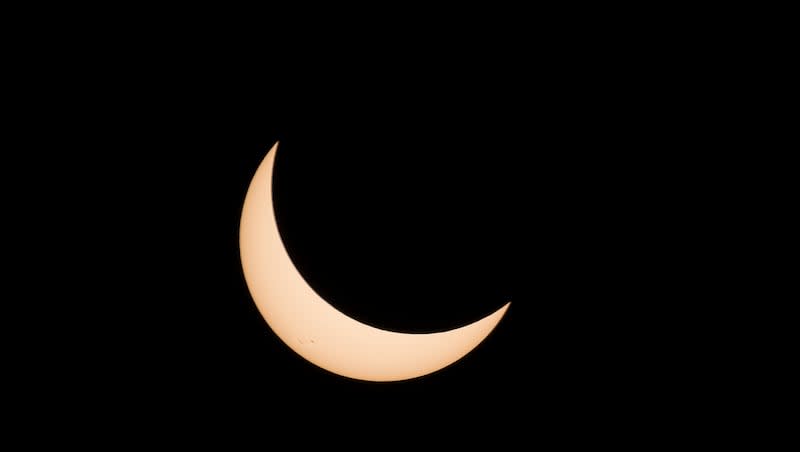What foods are associated with the solar eclipse?

Trying to come up with meals or snacks that celebrate the upcoming solar eclipse?
You can draw inspiration from historic culinary traditions or get creative with more modern eclipse-themed foods.
Are there foods associated with a solar eclipse?
Some ethnic or religious groups do not eat or drink food during a solar eclipse.
In Navajo tradition, for example, it is believed that during a solar eclipse, the sun experiences a process of rebirth. During this sacred time, members of the Navajo Nation sit and reflect, according to Sherene Goatson Ing, who is a member of the Navajo Nation and director of the First Nations Educational and Cultural Center at Indiana University Bloomington.
“The Navajo do not eat and drink or do any activity during the event; we just sit in reverence,” Ing told News at IU. “Because it’s a moment of rebirth, we just try to show respect.”
Similarly, many Hindus believe no food should be cooked during the eclipse. Some may put tulsi or Indian basil leaves on leftover food items to cover them for safety, according to India Today.
This food avoidance stems from the belief that during the solar eclipse, bacteria multiplies at a faster rate and contaminates food. Additionally, in the Skanda Purana, Hindu scripture, individuals are told not to serve food during this time or else they will suffer from bad health, per The Times of India.
According to NASA, eclipses will not poison the food you eat.
What did ancient civilizations believe about the solar eclipse?
Have you ever wondered how ancient civilizations interpreted the disappearance of the sun’s light during a solar eclipse? Often, the event was viewed with fear, as the Deseret News previously reported.
Here are some facts about responses to eclipses over time, including some food-related details.
China
In China, it was believed that, during an eclipse, a celestial dragon attacked and ate the sun. To frighten the dragon, individuals would make loud noises, such as banging drums, per Britannica.
Zongzi, also known as sticky rice dumplings or Chinese tamales, are a popular food item to have during the Dragon Boat Festival. You can find sticky rice, meat, salted duck egg yolks, Chinese sausage, beans or sweet fillings inside a bamboo leaf, according to The Woks of Life.
The Woks of Life shared six different recipes for Zongzi depending on what ingredients you would like and how you want to cook it.
India
In Hindu mythology, a demon named Rahu tried to drink the gods’ nectar for immortality but was caught by Vishnu and beheaded. His flying head is said to eclipse, or eat, the sun, per Britannica.
While not a recipe for immortality, try making a mango lassi, a traditional Indian drink to represent the gods’ nectar. The ingredients in this recipe from Swasthi’s Recipes include mangoes, curd, milk, sugar and cardamom powder.
Incan
The Inca worshipped Inti, the sun god, and believed solar eclipses signaled his anger. Spiritual leaders sought sacrifices and the emperor fasted during and after eclipses, according to Britannica.
If want to model Incan traditions, fast for a short time during and after the eclipse.
Jamaica
During his last voyage to the New World in March 1504, Christopher Columbus used his understanding of an upcoming lunar eclipse to persuade Jamaican natives to give him food. He warned them that his god would take away the moon if they weren’t generous. When the eclipse happened as he predicted, the Jamaicans brought food to Columbus and his crew, per USA Today.
Instead of tricking someone else into giving you eclipse-themed food, try bringing them a Jamaican dish. You can make a friend ackee and salt fish, the national dish of Jamaica, following Jamaican Foods and Recipes.
Vikings
During an eclipse, the Vikings believed the wolf Sköll caught up to the sun goddess Sól. If Sköll was able to swallow Sól and bring darkness, it signified the beginning of Ragnarok, the ultimate battle between the gods, and the end of the world, per News Nation.
To fuel up before a possible Ragnarok, it might be good to eat a typical Viking meal, which included fruit and berries, meat and fish, beer and mead, and bread or porridge, according to the National Museum of Denmark.
Solar eclipse-themed foods
As you learn about ancient cultures and their beliefs surrounding eclipses, you can consider how to reflect those beliefs in your solar eclipse celebrations.
But you can also embrace more modern traditions and more modern menu items.
Here’s a list of fun things to eat before, during or after the solar event:
Astronaut ice cream.
Black and white cookies. If you’re making them at home, try this recipe from Preppy Kitchen.
Black bean hummus or dip and chips.
Capri Sun juice pouches.
Crescent rolls.
Eclipse cupcakes. This recipe from Sugar Hero describes how to decorate the cupcakes to look like the stages of the solar eclipse.
Eclipse or Orbit gum.
Fruit and veggie skewers. Cut fruits or vegetables into sun, moon and star shapes, then stick them on a skewer.
Galaxy popcorn. Try this recipe from Raising Whasians.
Lemon Berry Tartlets. When finished, this tasty treat from Allrecipes looks like a creative replica of the moon (the berry) blocking the sun (the lemon).
Pizzas decorated like planets.
Space-themed candy or treats like Milky Ways, Starbursts, Moon Pies, Cosmic Brownies, Space Dunk Oreos or Mars Bars.
Squid or cuttlefish ink pasta. Here is a recipe from Platings + Pairings.
Star shaped cheese on crackers: Feel free to add toppers such as sun dried tomatoes.
Sun chips.
Sunflower seeds.
SunnyD.

